sat所有修辞手法
- 格式:pdf
- 大小:149.40 KB
- 文档页数:6
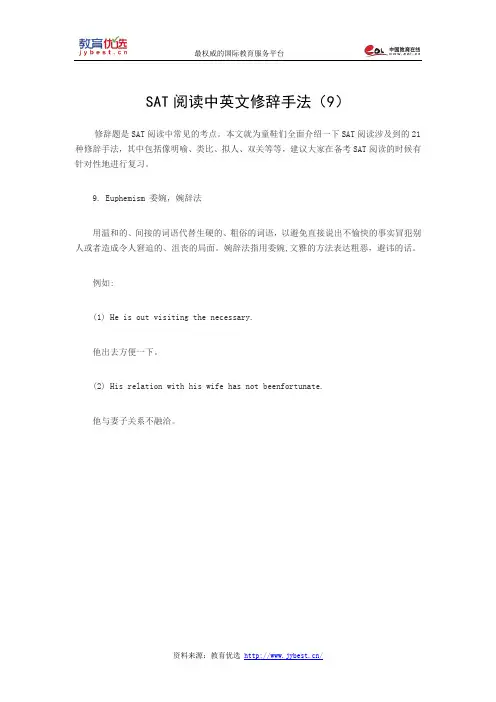
最权威的国际教育服务平台
资料来源:教育优选 /
SAT 阅读中英文修辞手法(9)
修辞题是SAT 阅读中常见的考点。
本文就为童鞋们全面介绍一下SAT 阅读涉及到的21种修辞手法,其中包括像明喻、类比、拟人、双关等等,建议大家在备考SAT 阅读的时候有针对性地进行复习。
9. Euphemism 委婉,婉辞法
用温和的、间接的词语代替生硬的、粗俗的词语,以避免直接说出不愉快的事实冒犯别人或者造成令人窘迫的、沮丧的局面。
婉辞法指用委婉,文雅的方法表达粗恶,避讳的话。
例如:
(1) He is out visiting the necessary.
他出去方便一下。
(2) His relation with his wife has not beenfortunate.
他与妻子关系不融洽。
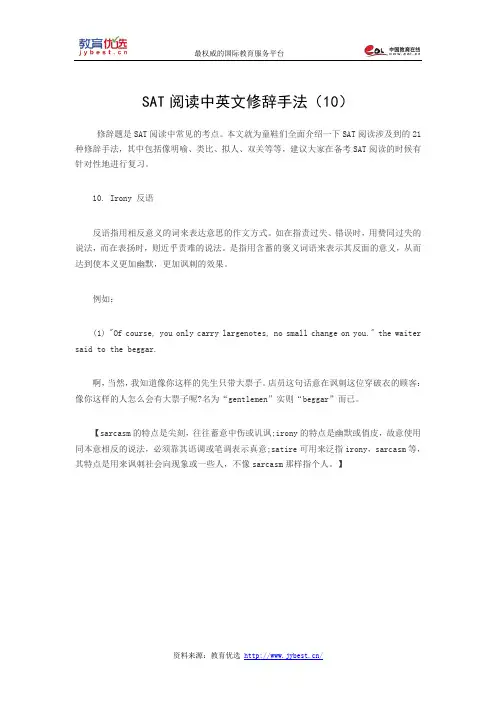
最权威的国际教育服务平台
资料来源:教育优选 /
SAT 阅读中英文修辞手法(10)
修辞题是SAT 阅读中常见的考点。
本文就为童鞋们全面介绍一下SAT 阅读涉及到的21种修辞手法,其中包括像明喻、类比、拟人、双关等等,建议大家在备考SAT 阅读的时候有针对性地进行复习。
10. Irony 反语
反语指用相反意义的词来表达意思的作文方式。
如在指责过失、错误时,用赞同过失的说法,而在表扬时,则近乎责难的说法。
是指用含蓄的褒义词语来表示其反面的意义,从而达到使本义更加幽默,更加讽刺的效果。
例如:
(1) "Of course, you only carry largenotes, no small change on you." the waiter said to the beggar.
啊,当然,我知道像你这样的先生只带大票子。
店员这句话意在讽刺这位穿破衣的顾客:像你这样的人怎么会有大票子呢?名为“gentlemen ”实则“beggar ”而已。
【sarcasm 的特点是尖刻,往往蓄意中伤或讥讽;irony 的特点是幽默或俏皮,故意使用同本意相反的说法,必须靠其语调或笔调表示真意;satire 可用来泛指irony ,sarcasm 等,其特点是用来讽刺社会向现象或一些人,不像sarcasm 那样指个人。
】。
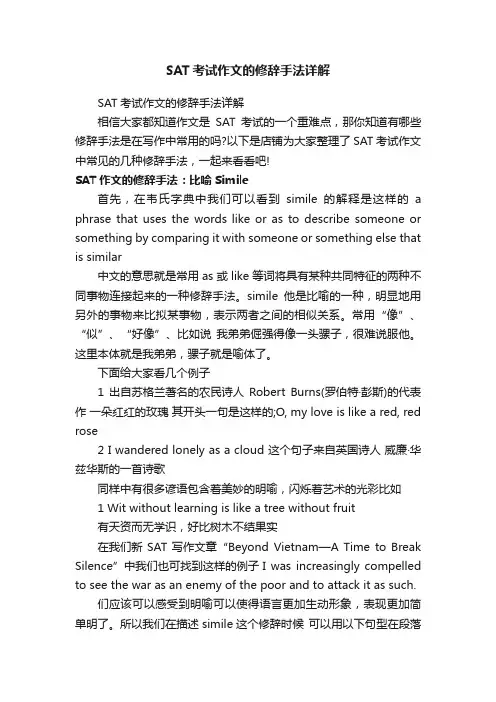
SAT考试作文的修辞手法详解SAT考试作文的修辞手法详解相信大家都知道作文是SAT考试的一个重难点,那你知道有哪些修辞手法是在写作中常用的吗?以下是店铺为大家整理了SAT考试作文中常见的几种修辞手法,一起来看看吧!SAT作文的修辞手法:比喻Simile首先,在韦氏字典中我们可以看到simile的解释是这样的a phrase that uses the words like or as to describe someone or something by comparing it with someone or something else that is similar中文的意思就是常用as或like等词将具有某种共同特征的两种不同事物连接起来的一种修辞手法。
simile他是比喻的一种,明显地用另外的事物来比拟某事物,表示两者之间的相似关系。
常用“像”、“似”、“好像”、比如说我弟弟倔强得像一头骡子,很难说服他。
这里本体就是我弟弟,骡子就是喻体了。
下面给大家看几个例子1 出自苏格兰著名的农民诗人Robert Burns(罗伯特·彭斯)的代表作一朵红红的玫瑰其开头一句是这样的;O, my love is like a red, red rose2 I wandered lonely as a cloud 这个句子来自英国诗人威廉·华兹华斯的一首诗歌同样中有很多谚语包含着美妙的明喻,闪烁着艺术的光彩比如1 Wit without learning is like a tree without fruit有天资而无学识,好比树木不结果实在我们新SAT写作文章“Beyond Vietnam—A Time to Break Silence”中我们也可找到这样的例子I was increasingly compelled to see the war as an enemy of the poor and to attack it as such.们应该可以感受到明喻可以使得语言更加生动形象,表现更加简单明了。
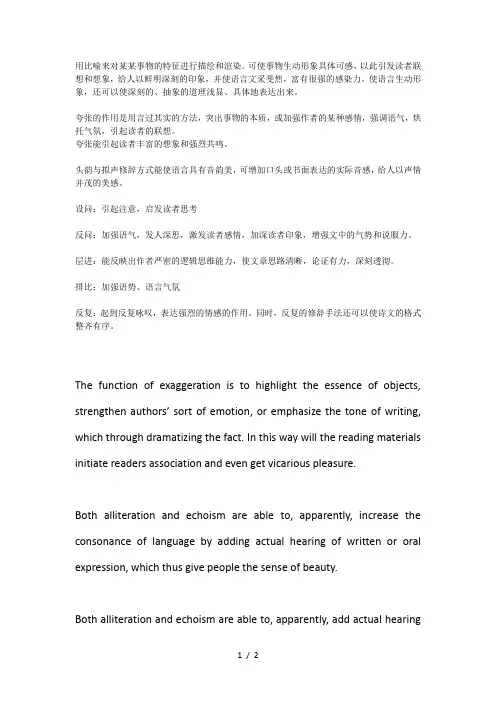
用比喻来对某某事物的特征进行描绘和渲染。
可使事物生动形象具体可感,以此引发读者联想和想象,给人以鲜明深刻的印象,并使语言文采斐然,富有很强的感染力。
使语言生动形象,还可以使深刻的、抽象的道理浅显、具体地表达出来。
夸张的作用是用言过其实的方法,突出事物的本质,或加强作者的某种感情,强调语气,烘托气氛,引起读者的联想。
夸张能引起读者丰富的想象和强烈共鸣。
头韵与拟声修辞方式能使语言具有音韵美,可增加口头或书面表达的实际音感,给人以声情并茂的美感。
设问:引起注意,启发读者思考反问:加强语气,发人深思,激发读者感情,加深读者印象,增强文中的气势和说服力。
层进:能反映出作者严密的逻辑思维能力,使文章思路清晰,论证有力,深刻透彻。
排比:加强语势、语言气氛反复:起到反复咏叹,表达强烈的情感的作用。
同时,反复的修辞手法还可以使诗文的格式整齐有序。
The function of exaggeration is to highlight the essence of objects, strengthen authors’ sort of emotion, or emphasize the tone of writing, which through dramatizing the fact. In this way will the reading materials initiate readers association and even get vicarious pleasure.Both alliteration and echoism are able to, apparently, increase the consonance of language by adding actual hearing of written or oral expression, which thus give people the sense of beauty.Both alliteration and echoism are able to, apparently, add actual hearingof written or oral expression,increase the consonance of language,and give people the sense of beauty.Describing or sensationalizing one certain characteristic of something in metaphorical terms can make the objects more vivid and specific, leaving readers immense imaginary space. Also, using metaphor in articles can impress people with extraordinary literary grace, for it makes the articles more catching and easy understanding through simplifying abstractive principles.Authors often arouse readers thinking or catch their attention using the method of questioning.Rhetorical questioning is a way to strengthen the tone of the article and increase the convincingness in order to create impact on readers.。
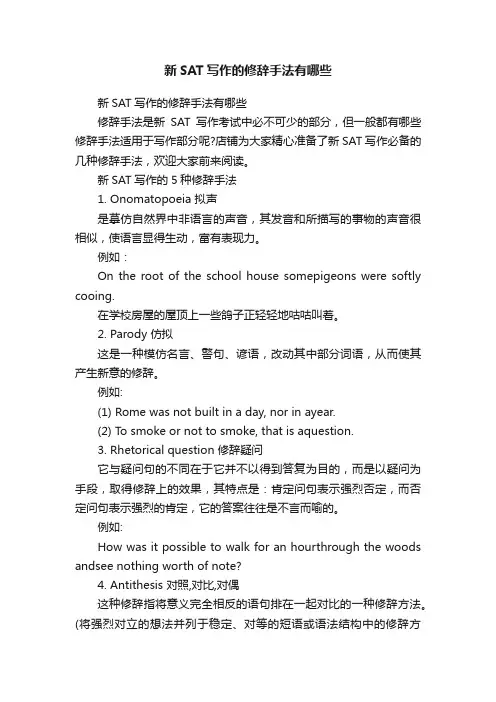
新SAT写作的修辞手法有哪些新SAT写作的修辞手法有哪些修辞手法是新SAT写作考试中必不可少的部分,但一般都有哪些修辞手法适用于写作部分呢?店铺为大家精心准备了新SAT写作必备的几种修辞手法,欢迎大家前来阅读。
新SAT写作的5种修辞手法1. Onomatopoeia 拟声是摹仿自然界中非语言的声音,其发音和所描写的事物的声音很相似,使语言显得生动,富有表现力。
例如:On the root of the school house somepigeons were softly cooing.在学校房屋的屋顶上一些鸽子正轻轻地咕咕叫着。
2. Parody 仿拟这是一种模仿名言、警句、谚语,改动其中部分词语,从而使其产生新意的修辞。
例如:(1) Rome was not built in a day, nor in ayear.(2) To smoke or not to smoke, that is aquestion.3. Rhetorical question 修辞疑问它与疑问句的不同在于它并不以得到答复为目的,而是以疑问为手段,取得修辞上的效果,其特点是:肯定问句表示强烈否定,而否定问句表示强烈的肯定,它的答案往往是不言而喻的。
例如:How was it possible to walk for an hourthrough the woods andsee nothing worth of note?4. Antithesis 对照,对比,对偶这种修辞指将意义完全相反的语句排在一起对比的一种修辞方法。
(将强烈对立的想法并列于稳定、对等的短语或语法结构中的修辞方法。
)例如:Pride hurts, modesty benefits.满招损,谦受益。
5. Symbolism 象征象征是通过一些具体形象,使人产生联想,从而表现与之相联系的某种抽象的概念、思想、感情,表现作品主题的艺术创作手法,属于文艺学范畴,它是一种写作手法。
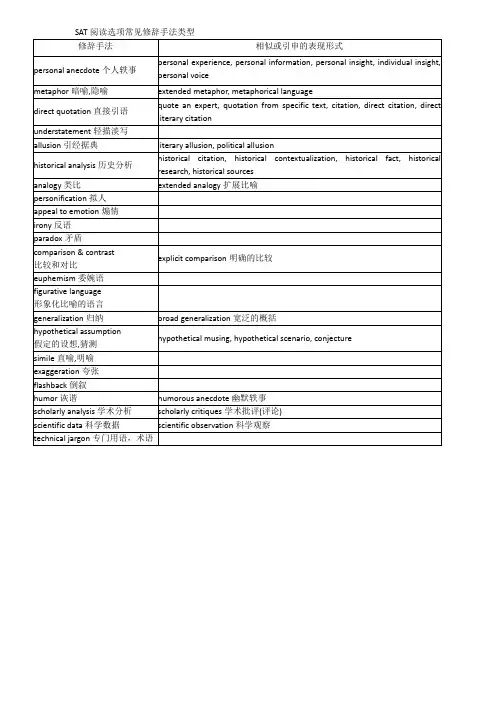
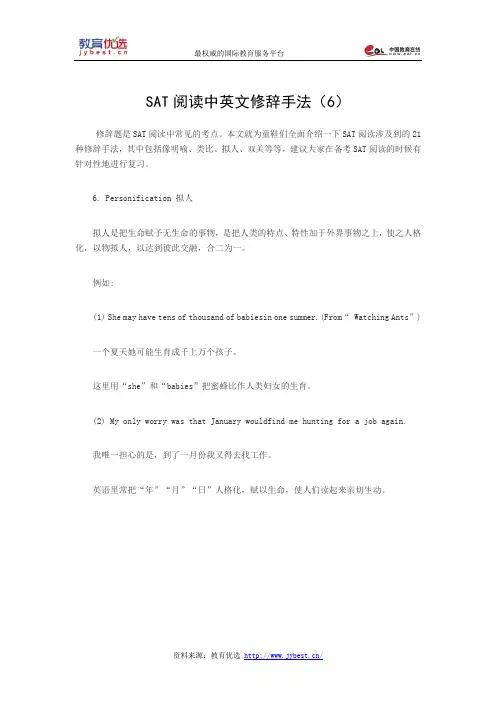
最权威的国际教育服务平台
资料来源:教育优选 /
SAT 阅读中英文修辞手法(6)
修辞题是SAT 阅读中常见的考点。
本文就为童鞋们全面介绍一下SAT 阅读涉及到的21种修辞手法,其中包括像明喻、类比、拟人、双关等等,建议大家在备考SAT 阅读的时候有针对性地进行复习。
6. Personification 拟人
拟人是把生命赋予无生命的事物,是把人类的特点、特性加于外界事物之上,使之人格化,以物拟人,以达到彼此交融,合二为一。
例如:
(1) She may have tens of thousand of babiesin one summer.(From “ Watching Ants ”) 一个夏天她可能生育成千上万个孩子。
这里用“she ”和“babies ”把蜜蜂比作人类妇女的生育。
(2) My only worry was that January wouldfind me hunting for a job again. 我唯一担心的是,到了一月份我又得去找工作。
英语里常把“年”“月”“日”人格化,赋以生命,使人们读起来亲切生动。
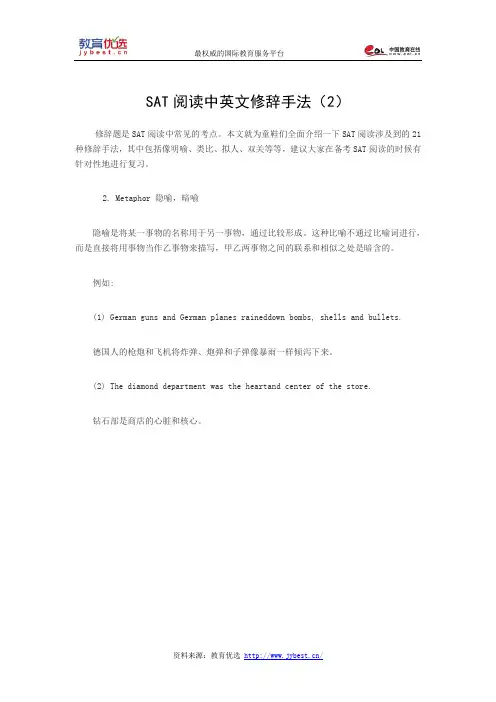
最权威的国际教育服务平台
资料来源:教育优选 /
SAT 阅读中英文修辞手法(2)
修辞题是SAT 阅读中常见的考点。
本文就为童鞋们全面介绍一下SAT 阅读涉及到的21种修辞手法,其中包括像明喻、类比、拟人、双关等等,建议大家在备考SAT 阅读的时候有针对性地进行复习。
2. Metaphor 隐喻,暗喻
隐喻是将某一事物的名称用于另一事物,通过比较形成。
这种比喻不通过比喻词进行,而是直接将用事物当作乙事物来描写,甲乙两事物之间的联系和相似之处是暗含的。
例如:
(1) German guns and German planes raineddown bombs, shells and bullets. 德国人的枪炮和飞机将炸弹、炮弹和子弹像暴雨一样倾泻下来。
(2) The diamond department was the heartand center of the store.
钻石部是商店的心脏和核心。

SAT写作常用的21种修辞方法发布时间:2017-12-05 编辑:少冰随着SAT的到来,考生是如何复习SAT考试的呢?下面是小编为大家整理收集的关于SAT写作常用的21种修辞方法,希望对大家有所帮助。
1. Simile 明喻明喻是将具有共性的不同事物作对比.这种共性存在于人们的心里,而不是事物的自然属性。
或者说是以两种具有相同特征的事物和现象进行对比,表明本体和喻体之间的相似关系,两者都在对比中出现。
标志词常用 like, as, seem, as if, as though, similar to, such as 等.例如:(1) He looked as if he had just stepped outof my book of fairytalesand had passed me like a spirit.他看上去好像刚从我的童话故事书中走出来,像幽灵一样从我身旁走过去。
(2) It has long leaves that sway in thewind like slim fingersreaching to touch something.它那长长的叶子在风中摆动,好像伸出纤细的手指去触摸什么东西似的。
2. Metaphor 隐喻,暗喻隐喻是将某一事物的名称用于另一事物,通过比较形成。
这种比喻不通过比喻词进行,而是直接将用事物当作乙事物来描写,甲乙两事物之间的联系和相似之处是暗含的。
例如:(1) German guns and German planes raineddown bombs, shells andbullets.德国人的枪炮和飞机将炸弹、炮弹和子弹像暴雨一样倾泻下来。
(2) The diamond department was the heartand center of thestore.钻石部是商店的心脏和核心。
3. Metonymy 借喻,转喻借喻不直接说出所要说的事物,而使用另一个与之相关的事物名称。
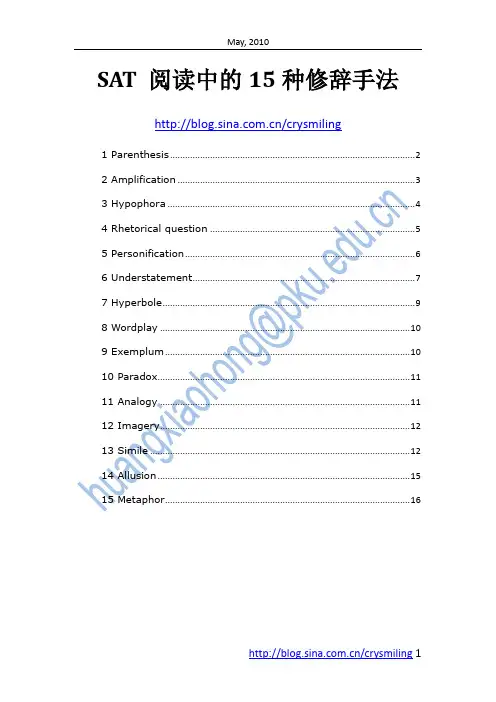
SAT 阅读中的15种修辞手法/crysmiling1 Parenthesis (2)2 Amplification (3)3 Hypophora (4)4 Rhetorical question (5)5 Personification (6)6 Understatement (7)7 Hyperbole (9)8 Wordplay (10)9 Exemplum (10)10 Paradox (11)11 Analogy (11)12 Imagery (12)13 Simile (12)14 Allusion (15)15 Metaphor (16)1 Parenthesis括弧,插入语,附带a final form of hyperbaton, consists of a word, phrase, or whole sentence inserted as an aside in the middle of another sentence:∙But the new calculations--and here we see the value of relying upon up-to-date information--showed that man-powered flight was possible with this design.∙Every time I try to think of a good rhetorical example, I rack my brains but--you guessed--nothing happens.∙As the earthy portion has its origin from earth, the watery from a different element, my breath from one source and my hot and fiery parts from another of their own elsewhere (for nothing comes from nothing, or can return to nothing), so too there must be an origin for the mind. --Marcus Aurelius∙But in whatever respect anyone else is bold (I speak in foolishness), I am just as bold myself. --2 Cor. 11:21b (NASB)The violence involved in jumping into (or out of) the middle of your sentence to address the reader momentarily about something has a pronounced effect. Parenthesis can be circumscribed either by dashes--they are more dramatic and forceful--or by parentheses (to make your aside less stringent).This device creates the effect of extemporaneity and immediacy: you are relating some fact when suddenly something very important arises, or else you cannot resist an instant comment, so you just stop the sentence and the thought you are on right where they are and insert the fact or comment.The parenthetical form also serves to give some statements a context (stuffed right into the middle of another sentence at the most pertinent point) which they would not have if they had to be written as complete sentences following another sentence.Note that in the first example above the bit of moralizing placed into the sentence appears to be more natural and acceptable than if it were stated separately as a kind of moral conclusion, which was not the purpose or drift of the article.2 Amplificationinvolves repeating a word or expression while adding more detail to it, in order to emphasize what might otherwise be passed over. In other words, amplification allows you to call attention to, emphasize, and expand a word or idea to make sure the reader realizes its importance or centrality in the discussion.∙In my hunger after ten days of rigorous dieting I saw visions of ice cream--mountains of creamy, luscious ice cream, dripping with gooey syrup and calories.∙This orchard, this lovely, shady orchard, is the main reason I bought this property.∙. . . Even in Leonardo's time, there were certain obscure needs and patterns of the spirit, which could discover themselves only through less precise analogies--the analogies provided by stains on walls or the embers of a fire.--Kenneth Clark∙Pride--boundless pride--is the bane of civilization.∙He showed a rather simple taste, a taste for good art, good food, and good friends.But amplification can overlap with or include a repetitive device like anaphora when the repeated word gains further definition or detail:∙The Lord also will be a refuge for the oppressed,/ A refuge in times of trouble.--Psalm 9:9 (KJV)Notice the much greater effectiveness this repetition-plus detail form can have over a "straight" syntax. Compare each of these pairs:∙The utmost that we can threaten to one another is death, a death which, indeed, we may precipitate, but cannot retard, and from which, therefore, it cannot become a wise man to buy a reprieve at the expense of virtue, since he knows not how small a portion of time he can purchase, but knows that, whether short or long, it will be made less valuable by the remembrance of the price at which it has been obtained. --adapted from S. Johnson ∙The utmost that we can threaten to one another is that death which, indeed, we may precipitate . . . .∙In everything remember the passing of time, a time which cannot be called again.∙In everything remember the passing of a time which cannot be called again.3 Hypophora设问consists of raising one or more questions and then proceeding to answer them, usually at some length. A common usage is to ask the question at the beginning of a paragraph and then use that paragraph to answer it:∙There is a striking and basic difference between a man's ability to imagine something and an animal's failure. . . . Where is it that the animal falls short?We get a clue to the answer, I think, when Hunter tells us . . . . --Jacob Bronowski∙What then shall we say that Abraham, our forefather, discovered in this matter?. . . What does the Scripture say? "Abraham believed God. --Rom.4:1,3 (NIV)This is an attractive rhetorical device, because asking an appropriate question appears quite natural and helps to maintain curiosity and interest. You can use hypophora to raise questions which you think the reader obviously has on his mind and would like to see formulated and answered:∙What behavior, then, is uniquely human? My theory is this . . . . --H. J.Campbell∙But what was the result of this move on the steel industry? The annual reports for that year clearly indicate. . . .Hypophora can also be used to raise questions or to introduce material of importance, but which the reader might not have the knowledge or thought to ask for himself:∙How then, in the middle of the twentieth century, are we to define the obligation of the historian to his facts?..... The duty of the historian to respect his facts is not exhausted by . . . . --Edward Hallett Carr ∙But it is certainly possible to ask, How hot is the oven at its hottest point, when the average temperature is 425 degrees? We learned that the peak temperatures approached . . . .And hypophora can be used as a transitional or guiding device to change directions or enter a new area of discussion:∙But what are the implications of this theory? And how can it be applied to the present problem?∙How and why did caveat emptor develop? The question presents us with mysteries never fully answered. --Ivan L. PrestonNotice how a series of reasonable questions can keep a discussion lively and interesting:∙How do we know the FTC strategy is the best, particularly in view of the complaints consumerists have made against it? Isn't there some chance that greater penalties would amount to greater deterrents? Why not get the most consumer protection simultaneously with the most punishment to offenders by easing the requirements for guilt without easing the punishment? . . . It happens that that's been tried, and it didn't work very well. --Ivan L. PrestonIn the above example, the writer went on for several paragraphs to discuss the case which "didn't work very well." It would also be possible for a writer to ask several questions and then answer them in an orderly way, though that has the danger of appearing too mechanical if not carefully done.4 Rhetorical question反问(erotesis) differs from hypophora in that it is not answered by the writer, because its answer is obvious or obviously desired, and usually just a yes or no. It is used for effect, emphasis, or provocation, or for drawing a conclusionary statement from the facts at hand.∙But how can we expect to enjoy the scenery when the scenery consists entirely of garish billboards?∙. . . For if we lose the ability to perceive our faults, what is the good of living on? --Marcus Aurelius∙Is justice then to be considered merely a word? Or is it whatever results from the bartering between attorneys?Often the rhetorical question and its implied answer will lead to further discussion:∙Is this the end to which we are reduced? Is the disaster film the highest form of art we can expect from our era? Perhaps we should examine the alternatives presented by independent film maker Joe Blow . . . .∙I agree the funding and support are still minimal, but shouldn't worthy projects be tried, even though they are not certain to succeed? So the plans in effect now should be expanded to include . . . . [Note: Here is an example where the answer "yes" is clearly desired rhetorically by the writer, though conceivably someone might say "no" to the question if asked straightforwardly.]Several rhetorical questions together can form a nicely developed and directed paragraph by changing a series of logical statements into queries:∙We shrink from change; yet is there anything that can come into being without it? What does Nature hold dearer, or more proper to herself? Could you have a hot bath unless the firewood underwent some change? Could you be nourished if the food suffered no change? Do you not see, then, that change in yourself is of the same order, and no less necessary to Nature?--Marcus AureliusSometimes the desired answer to the rhetorical question is made obvious by the discussion preceding it:∙The gods, though they live forever, feel no resentment at having to put up eternally with the generations of men and their misdeeds; nay more, they even show every possible care and concern for them. Are you, then, whose abiding is but for a moment, to lose patience--you who are yourself one of the culprits? --Marcus AureliusWhen you are thinking about a rhetorical question, be careful to avoid sinking to absurdity. You would not want to ask, for example, "But is it right to burn down the campus and sack the bookstore?" The use of this device allows your reader to think, query, and conclude along with you; but if your questions become ridiculous, your essay may become wastepaper.5 Personification拟人metaphorically represents an animal or inanimate object as having human attributes--attributes of form, character, feelings, behavior, and so on. Ideas and abstractions can also be personified.∙The ship began to creak and protest as it struggled against the rising sea.∙We bought this house instead of the one on Maple because this one is more friendly.∙This coffee is strong enough to get up and walk away.∙I can't get the fuel pump back on because this bolt is being uncooperative.∙Your brother's blood cries out to me from the ground. --Genesis 4:10b (NIV)∙That ignorance and perverseness should always obtain what they like was never considered as the end of government; of which it is the great and standing benefit that the wise see for the simple, and the regular act for the capricious. --Samuel Johnson∙Wisdom cries aloud in the streets; in the markets she raises her voice . . . .--Psalm 1:20 (RSV; and cf. 1:21-33)While personification functions primarily as a device of art, it can often serve to make an abstraction clearer and more real to the reader by defining or explaining the concept in terms of everyday human action (as for example man's rejection of readily available wisdom is presented as a woman crying out to be heard but being ignored). Ideas can be brought to life through personification and objects can be given greater interest. But try always to be fresh: "winking stars" is worn out; "winking dewdrops" may be all right.Personification of just the natural world has its own name, fictio. And when this natural-world personification is limited to emotion, John Ruskin called it the pathetic fallacy. Ruskin considered this latter to be a vice because it was so often overdone (and let this be a caution to you). We do not receive much pleasure from an overwrought vision like this:∙The angry clouds in the hateful sky cruelly spat down on the poor man who had forgotten his umbrella.Nevertheless, humanizing a cold abstraction or even some natural phenomenon gives us a way to understand it, one more way to arrange the world in our own terms, so that we can further comprehend it. And even the so-called pathetic fallacy can sometimes be turned to advantage, when the writer sees his own feelings in the inanimate world around him:∙After two hours of political platitudes, everyone grew bored. The delegates were bored; the guests were bored; the speaker himself was bored. Even the chairs were bored.6 Understatement有保留地陈述、含蓄(间接)表达deliberately expresses an idea as less important than it actually is, either for ironic emphasis or for politeness and tact. When the writer's audience can be expected to know the true nature of a fact which might be rather difficult to describe adequately in a brief space, the writer may choose to understate the fact as a means of employing the reader's own powers of description. For example, instead of endeavoring to describe in a few words the horrors and destruction of the 1906 earthquake in San Francisco, a writer might state:∙The 1906 San Francisco earthquake interrupted business somewhat in the downtown area.The effect is not the same as a description of destruction, since understatement like this necessarily smacks of flippancy to some degree; but occasionally that is a desirable effect. Consider these usages:∙Henry and Catherine were married, the bells rang, and everybody smiled . . . . To begin perfect happiness at the respective ages of twenty-six and eighteen is to do pretty well . . . . --Jane Austen∙Last week I saw a woman flayed, and you will hardly believe how much it altered her person for the worse. --Jonathan Swift∙You know I would be a little disappointed if you were to be hit by a drunk driver at two a.m., so I hope you will be home early.In these cases the reader supplies his own knowledge of the facts and fills out a more vivid and personal description than the writer might have.In a more important way, understatement should be used as a tool for modesty and tactfulness. Whenever you represent your own accomplishments, and often when you just describe your own position, an understatement of the facts will help you to avoid the charge of egotism on the one hand and of self-interested puffery on the other. We are always more pleased to discover a thing greater than promised rather than less than promised--or as Samuel Johnson put it, "It is more pleasing to see smoke brightening into flame, than flame sinking into smoke." And it goes without saying that a person modest of his own talents wins our admiration more easily than an egotist. Thus an expert geologist might say, "Yes, I know a little about rocks," rather than, "Yes, I'm an expert about rocks." (An even bigger expert might raise his eyebrows if he heard that.)Understatement is especially useful in dealing with a hostile audience or in disagreeing with someone, because the statement, while carrying the same point, is much less offensive. Compare:∙The second law of thermodynamics pretty much works against the possibility of such an event.∙The second law of thermodynamics proves conclusively that that theory is utterly false and ridiculous.Remember, the goal of writing is to persuade, not to offend; once you insult or put off your opponent, objector, or disbeliever, you will never persuade him of anything, no matter how "obviously wrong" he is or how clearly right you are. The degree and power of pride in the human heart must never be underestimated. Many people are unwilling to hear objections of any kind, and view disagreement as a sign of contempt for their intellect. The use of understatement allows you to show a kind of respect for your reader's understanding. You have to object to his belief, but you are sympathetic with his position and see how he might have come to believe it; therefore, you humbly offer to steer him right, or at least to offer what you think isa more accurate view. Even those who agree with you already will be more persuaded because the modest thinker is always preferable to the flaming bigot. Compare these statements and consider what effect each would have on you if you read them in a persuasive article:∙Anyone who says this water is safe to drink is either stupid or foolish. The stuff is poisoned with coliform bacteria. Don't those idiots know that?∙My opponents think this water is drinkable, but I'm not sure I would drink it.Perhaps they are not aware of the dangerous bacterial count . . . [and so on, explaining the basis for your opinion].Litotes,a particular form of understatement, is generated by denying the opposite or contrary of the word which otherwise would be used. Depending on the tone and context of the usage, litotes either retains the effect of understatement, or becomes an intensifying expression. Compare the difference between these statements:∙Heat waves are common in the summer.∙Heat waves are not rare in the summer.7 Hyperbole夸张Exaggeration: used to evoke strong feelings or create an impression which is not meant to be taken literally.(exaggeration) the counterpart of understatement, deliberately exaggerates conditions for emphasis or effect. In formal writing the hyperbole must be clearly intended as an exaggeration, and should be carefully restricted. That is, do not exaggerate everything, but treat hyperbole like an exclamation point, to be used only once a year. Then it will be quite effective as a table-thumping attention getter, introductory to your essay or some section thereof:∙There are a thousand reasons why more research is needed on solar energy. Or it can make a single point very enthusiastically:∙I said "rare," not "raw." I've seen cows hurt worse than this get up and get well.Or you can exaggerate one thing to show how really different it is from something supposedly similar to which it is being compared:∙This stuff is used motor oil compared to the coffee you make, my love.∙If anyone comes to me, and does not hate his own father and mother and wife and children and brothers and sisters, yes, and even his own life, he cannot be my disciple. --Luke 14:26 (NASB)Hyperbole is the most overused and overdone rhetorical figure in the whole world (and that is no hyperbole); we are a society of excess and exaggeration. Nevertheless, hyperbole still has a rightful and useful place in art and letters; just handle it like dynamite, and do not blow up everything you can find.8 Wordplay双关语,俏皮话Word play is a literary technique in which the words that are used become the main subject of the work, primarily for the purpose of intended effect or amusement. Word play is quite common in oral cultures as a method of reinforcing meaning.Puns, phonetic mix-ups such as spoonerisms, obscure words and meanings, oddly formed sentences are common examples of word play.9 Exemplum举例子citing an example; using an illustrative story, either true or fictitious:∙Let me give you an example. In the early 1920's in Germany, the government let the printing presses turn out endless quantities of papermoney, and soon, instead of 50-pfennige postage stamps, denominations up to 50 billion marks were being issued.Examples can be introduced by the obvious choice of "For example," but there are other possibilities. For quick introductions, such as those attached to a sentence, you migiht use "such as," or "for instance." Examples placed into separate sentences can be introduced by "A case in point," "An instance," "A typical situation," "A common example," "To illustrate, let's consider the situation," and so forth.10 Paradox悖论, 似非而是的论点, 自相矛盾的话A phrase that describes an idea composed of concepts that conflict, e.g., "It was the best of times, it was the worst of times." (A Tale of Two Cities)11 Analogy类比、类推e.g. Menhaden are filter feeders that help control the growth of algae devastating to coastal fisheries. Marine biologist Sara Gottlieb says, “Think of menhaden as the liver of a bay. Just as your body needs its liver to filter out toxins, ecosystems also need those natural filters.”--- 选自SAT 2009年1月真题Analogy compares two things, which are alike in several respects, for the purpose of explaining or clarifying some unfamiliar or difficult idea or object by showing how the idea or object is similar to some familiar one. While simile and analogy often overlap, the simile(明喻)is generally a more artistic likening, done briefly for effect and emphasis, while analogy serves the more practical end of explaining a thought process or a line of reasoning or the abstract in terms of the concrete, and may therefore be more extended.∙You may abuse a tragedy, though you cannot write one. You may scold a carpenter who has made you a bad table, though you cannot make a table.It is not your trade to make tables. --Samuel Johnson∙He that voluntarily continues ignorance is guilty of all the crimes which ignorance produces, as to him that should extinguish the tapers of a lighthouse might justly be imputed the calamities of shipwrecks. --Samuel Johnson∙. . . For answers successfully arrived at are solutions to difficulties previously discussed, and one cannot untie a knot if he is ignorant of it. --AristotleNotice in these examples that the analogy is used to establish the pattern of reasoning by using a familiar or less abstract argument which the reader can understand easily and probably agree with.Some analogies simply offer an explanation for clarification rather than a substitute argument:∙Knowledge always desires increase: it is like fire, which must first be kindled by some external agent, but which will afterwards propagate itself. --Samuel Johnson∙The beginning of all evil temptations is inconstancy of mind, and too little trust in God. For as a ship without a guide is driven hither and thither with every storm, so an unstable man, that anon leaveth his good purpose in God, is diversely tempted. The fire proveth gold, and temptation proveth the righteous man. --Thomas a KempisWhen the matter is complex and the analogy particularly useful for explaining it, the analogy can be extended into a rather long, multiple-point comparison:The importance of simile and analogy for teaching and writing cannot be overemphasized. To impress this upon you better, I would like to step aside a moment and offer two persuasive quotations:∙The country parson is full of all knowledge. They say, it is an ill mason that refuseth any stone: and there is no knowledge, but, in a skilful hand, serves either positively as it is, or else to illustrate some other knowledge. He condescends even to the knowledge of tillage, and pastorage, and makes great use of them in teaching, because people by what they understand are best led to what they understand not. --George Herbert∙To illustrate one thing by its resemblance to another has been always the most popular and efficacious art of instruction. There is indeed no other method of teaching that of which anyone is ignorant but by means of something already known; and a mind so enlarged by contemplation and enquiry that it has always many objects within its view will seldom be long without some near and familiar image through which an easy transition may be made to truths more distant and obscure. --Samuel Johnson12 ImageryForming mental images of a scene using descriptive words, especially making use of the human senses.13 Simile明喻is a comparison between two different things that resemble each other in at least one way. In formal prose the simile is a device both of art and explanation,comparing an unfamiliar thing to some familiar thing (an object, event, process, etc.) known to the reader.When you compare a noun to a noun, the simile is usually introduced by like:∙I see men, but they look like trees, walking. --Mark 8:24∙After such long exposure to the direct sun, the leaves of the houseplant looked like pieces of overcooked bacon.∙The soul in the body is like a bird in a cage.When a verb or phrase is compared to a verb or phrase, as is used: ∙They remained constantly attentive to their goal, as a sunflower alwaysturns and stays focused on the sun.∙Here is your pencil and paper. I want you to compete as the greatest hero would in the race of his life.Often the simile--the object or circumstances of imaginative identity (called the vehicle, since it carries or conveys a meaning about the word or thing which is likened to it)-precedes the thing likened to it (the tenor). In such cases, so usually shows the comparison:∙The grass bends with every wind; so does Harvey.∙The seas are quiet when the winds give o're; / So calm are we when passions are no more. --Edmund WallerBut sometimes the so is understood rather than expressed:∙As wax melts before the fire,/ may the wicked perish before God. --Psalm 68:2bWhenever it is not immediately clear to the reader, the point of similarity between the unlike objects must be specified to avoid confusion and vagueness. Rather than say, then, that "Money is like muck," and "Fortune is like glass," a writer will show clearly how these very different things are like each other: ∙And money is like muck, not good except it be spread. --Francis Bacon ∙Fortune is like glass--the brighter the glitter, the more easily broken.--Publilius Syrus∙Like a skunk, he suffered from bad publicity for one noticeable flaw, but bore no one any ill will.∙James now felt like an old adding machine: he had been punched and poked so much that he had finally worn out.∙This paper is just like an accountant's report: precise and accurate but absolutely useless.Many times the point of similarity can be expressed in just a word or two: ∙Yes, he is a cute puppy, but when he grows up he will be as big as ahouse.∙The pitching mound is humped too much like a camel's back.And occasionally, the simile word can be used as an adjective:∙The argument of this book utilizes pretzel-like logic.∙This gear has a flower-like symmetry to it.Similes can be negative, too, asserting that two things are unlike in one or more respects:∙My mistress' eyes are nothing like the sun. . . . --Shakespeare∙John certainly does not attack the way a Sherman tank does; but if you encourage him, he is bold enough.Other ways to create similes include the use of comparison:∙Norman was more anxious to leave the area than Herman Milquetoast after seeing ten abominable snowmen charging his way with hunger in their eyes.∙But this truth is more obvious than the sun--here it is; look at it; its brightness blinds you.Or the use of another comparative word is possible:∙Microcomputer EPROM (Erasable Programmable Read Only Memory) resembles a chalk board in that it is used for consultation instead of figuring, and shows at each glance the same information unless erased and rewritten.∙His temper reminds me of a volcano; his heart, of a rock; his personality, of sandpaper.∙His speech was smoother than butter. . . .--Psalm 55:21So a variety of ways exists for invoking the simile. Here are a few of the possibilities:But a simile can sometimes be implied, or as it is often called, submerged. In such cases no comparative word is needed:∙The author of this poem is almost in the position of a man with boxes and boxes of tree ornaments, but with no tree to decorate. The poet has enough imagery handy to decorate anything he can think of, if only he can fix upon a "trim invention." The "sense" he does locate is obscured;the ivy hides the building completely.∙When I think of the English final exam, I think of dungeons and chains and racks and primal screams.∙Leslie has silky hair and the skin of an angel.14 Allusion引用典故、暗指、间接提及Allusion is a short, informal reference to a famous person or event:∙You must borrow me Gargantua's mouth first. 'Tis a word too great for any mouth of this age's size. --Shakespeare∙If you take his parking place, you can expect World War II all over again.∙Plan ahead: it wasn't raining when Noah built the ark. --Richard Cushing ∙Our examination of the relation of the historian to the facts of history finds us, therefore, in an apparently precarious situation, navigating delicately between the Scylla of an untenable theory of history as an objective compilation of facts . . . and the Charybdis of an equally untenable theory of history as the subjective product of the mind of the historian . . . . --Edward Hallett CarrNotice in these examples that the allusions are to very well known characters or events, not to obscure ones. (The best sources for allusions are literature, history, Greek myth, and the Bible.) Note also that the reference serves to explain or clarify or enhance whatever subject is under discussion, without sidetracking the reader.Allusion can be wonderfully attractive in your writing because it can introduce variety and energy into an otherwise limited discussion (an exciting historical adventure rises suddenly in the middle of a discussion of chemicals or some abstract argument), and it can please the reader by reminding him of a pertinent story or figure with which he is familiar, thus helping (like analogy) to explain something difficult. The instantaneous pause and reflection on the analogy refreshes and strengthens the reader's mind.。
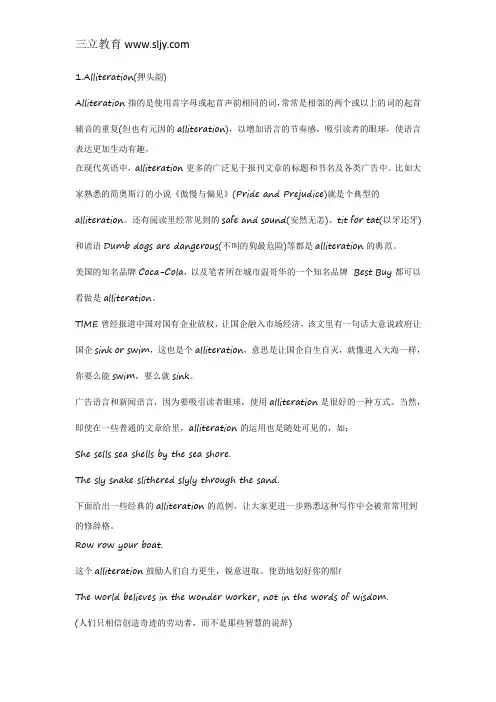
1.Alliteration(押头韵)Alliteration指的是使用首字母或起首声韵相同的词,常常是相邻的两个或以上的词的起首辅音的重复(但也有元因的alliteration),以增加语言的节奏感,吸引读者的眼球,使语言表达更加生动有趣。
在现代英语中,alliteration更多的广泛见于报刊文章的标题和书名及各类广告中。
比如大家熟悉的简奥斯汀的小说《傲慢与偏见》(Pride and Prejudice)就是个典型的alliteration。
还有阅读里经常见到的safe and sound(安然无恙)、tit for tat(以牙还牙)和谚语Dumb dogs are dangerous(不叫的狗最危险)等都是alliteration的典范。
美国的知名品牌Coca-Cola,以及笔者所在城市温哥华的一个知名品牌Best Buy都可以看做是alliteration。
TIME曾经报道中国对国有企业放权,让国企融入市场经济,该文里有一句话大意说政府让国企sink or swim,这也是个alliteration,意思是让国企自生自灭,就像进入大海一样,你要么能swim,要么就sink。
广告语言和新闻语言,因为要吸引读者眼球,使用alliteration是很好的一种方式。
当然,即使在一些普通的文章给里,alliteration的运用也是随处可见的,如:She sells sea shells by the sea shore.The sly snake slithered slyly through the sand.下面给出一些经典的alliteration的范例,让大家更进一步熟悉这种写作中会被常常用到的修辞格。
Row row your boat.这个alliteration鼓励人们自力更生,锐意进取。
使劲地划好你的船!The world believes in the wonder worker, not in the words of wisdom.(人们只相信创造奇迹的劳动者,而不是那些智慧的说辞)本句中,wonder worker是一个alliteration,words of wisdom也是个alliteration。
Allegory讽喻:The term loosely describes any writing in verse or prose that has a double meaning. This narrative acts as an extended metaphor in which persons, abstract ideas, or events represent not only themselves on the literal level, but they also stand for something else on the symbolic level.An allegorical reading usually involves moral or spiritual concepts that may be more significant than the actual, literal events described in a narrative. Typically, an allegory involves the interaction of multiple symbols, which together create a moral, spiritual, or even political meaning.Probably the most famous allegory in English literature is John Bunyan's Pilgrim's Progress (1678), in which the hero named Christian flees the City of Destruction and travels through the V alley of the Shadow of Death, V anity Fair, DoubtingCastle, and finally arrives at the CelestialCity. The entire narrative is a representation of the human soul's pilgrimage through temptation and doubt to reach salvation in heaven.Alliteration头韵: Repeating a consonant sound in close proximity to others, or beginning several words with the same vowel sound. For instance, the phrase "buckets of big blue berries"alliterates with the consonant b.押头韵技巧在一般英美报刊也得到了普遍使用。
文都国际教育官方网站:/SAT写作修辞手法运用在SAT写作中使用一些修辞手法会让你的作文增色不少。
今天小编为大家介绍一下SAT写作中夸张和拟人两种修辞手法的运用,供大家参考。
1. Hyperbole 夸张夸张是以言过其实的说法表达强调的目的.它可以加强语势,增加表达效果。
运用丰富的想象,过激的言词,渲染和装饰客观事物,以达到强调的效果。
例如:(1) My blood froze. 我的血液都凝固了。
When I told our father about this, his heart burst.当我将这件事告诉我们的父亲时,他的心几乎要迸出来。
(2) My heart almost stopped beating when I heard my daughter’s voice on the phone.从电话里一听到我女儿的声音,我的心几乎停止跳动。
2. Personification 拟人拟人是把生命赋予无生命的事物,是把人类的特点、特性加于外界事物之上,使之人格化,以物拟人,以达到彼此交融,合二为一。
例如:(1) She may have tens of thousand of babies in one summer.(From “ Watching Ants”)一个夏天她可能生育成千上万个孩子。
这里用“she”和“babies”把蜜蜂比作人类妇女的生育。
(2) My only worry was that January would find me hunting for a job again.我唯一担心的是,到了一月份我又得去找工作。
英语里常把“年”“月”“日”人格化,赋以生命,使人们读起来亲切生动。
以上就是SAT写作修辞夸张和拟人手法的介绍。
同学们可以把这两种修辞手法用在自己的作文中。
最后,小编预祝大家取得理想的成绩!文章来源于文都国际教育:/kaopei/20170705/9447.shtml文都国际教育官方网站:/。
1. FIGURATIVE/METAPHORICAL LANGUAGE比喻/隐喻—A general term referring to language that describes a thing in terms of something else. The resemblance is FIGURATIVE, not LITERAL, as the reader is carried beyond the LITERAL meaning to consider the NUANCES and connotations of the words used in the comparison.2. SIMILE明喻—An EXPLICIT figure of speech that is a comparison between two essentially unlike things, usually using the words “like” or “as,” which points out a FIGURATIVE way that the two things ARE alike.3. METAPHOR隐喻—In its more narrow sense, a figure of speech in which one thing is described in terms of another using an IMPLICIT or implied comparison, without the use of “like” or “as.”(09-5-5-19)4. PERSONIFICATION拟人—A figure of speech in which an inanimate object is given human qualities or abilities5. PARALLELISM/PARALLEL STRUCTURE/ REPETITION平行重复—A rhetorical device or SYNTACTICAL construction which involves using matching grammatical patterns to establish the equivalent relationship or importance of two or more items. PARALLELISM provides balance and authority to sentences.(09-5-7-24)[例] We are now living in a changing world in a changing time. With no gratitude in our hearts, we will be in a lonely world living a lonely life.6. IRONY讽刺—A figure of speech in which what we say or write conveys the opposite of its literal meaning7. SYNOPSIS总结—A brief summary of the major points ofa thesis, theory, story or literary work; an abstract; a PRÉCIS8. SATIRE, LAMPOON, PARODY模仿性嘲弄—A work that ridicules human vices and follies; comic criticism. Note that LAMPOON and PARODY are often used as verbs meaning to ridicule.9. HYPERBOLE夸张—A figure of speech in which exaggeration is used for emphasis or effect; extreme exaggeration注意反过来:UNDERESTIMATE低调陈述---a statement that is not strong enough to express facts or feelings with full force(语气不够强,不足以表达事实或感情的陈述)(06-1-9-11)。
Doctors, architects, executives, consultants, receptionists, and lawyers all manage to survive economically without "owning" their cognition. I take further comfort in the fact that the human species managed to produce pretty decent creative work during the 5,000 years that preceded 1710, when the Statute of Anne, the world's first modem copyright law, passed the British parliament Sophocles, Dante, da Vinci, Botticelli, Michelangelo, Shakespeare, Newton, Cervantes, Bach— all found reasons to get out of bed in the morning without expecting to own the works they created.15. The use of the phrase "pretty decent" in Passage 2(line 50) conveys(A) solemn detachment(B) cheerful celebration(C) ironic understatement(D) lingering doubt(E) reluctant approval10. CARICATURE喜剧夸张漫画—A representation in which the subject’s distinctive features or peculiarities are deliberately exaggerated for comic effect11. EPIC颂扬长诗—A long narrative poem written in a grand style to celebrate the feats of a legendary hero; SAGA英雄故事—A long narrative story; a heroic tale12. FORESHADOWING铺垫—A suggestion or indication that something will happen in a story; a hint that PRESAGES13. ANECDOTE/personal experience,personal information, personal insight, individual insight, personal voice讲故事—A short account of an interesting or humorousincident(og3-4-15)最高频,注意:个人轶事(anecdote )和概括 (generalization)如果用一些故事、经历来说明一个道理或者支撑一个观点就叫做Anecdote. 如果这种经历或故事还是作者的,那就是“Personal Anecdote”如果是通过泛泛地推理,而没有故事或者经历来佐证,就是Generalization或者叫“Broad Generalization”14. EULOGY赞词—A LAUDATOR Y speech or written tribute, especially one praising someone who has died15. ALLUSION暗指/典故—An indirect or brief reference toa person, event, place, phrase, piece of art, or literary work that assumes a common knowledge with the reader or listener 16. ANALOGY类比--Analogy is based on comparison between two subjects. It draws a parallel between two unlike things that have several common qualities or points of resemblance.类比是基于两事物的比较。
在不同的事物之间找到相同点,建立联系。
(09-1-3-7)Eg:Teachers who possess power and exert it to conduct class play a similar role as business managers.17. WORDPLAY双关---the witty exploitation of the meanings and ambiguities of words, esp. in puns. 同义词:punning, puns, play on words; wit, witticisms;[例] 如果没有联想,世界将会怎样。
Sofa, so good. = So far, so good.18. 头韵法(alliteration)在文句中有两个以上连结在一起的词或词组,其开头的音节有同样的字母或声音,以增强语言的节奏感.[例] New Jersey is a story of struggle, success, and sadness. 19.反问句(rhetorical question)设立一个不需要回答的问题,以起到戏剧或者强调的效果[例] 1.Did you help me when I needed help? 在我需要的时候,你帮助过我吗?2. Did you once offer to intercede in my behalf? 你曾经理解支持过我吗?20. 层进法(climax)通过一系列观念、形象的修辞安排,逐步把意思往前推进,最有力量的放在最后和突降法(anti-climax )与 climax 相反的一种修辞法,将一系列词语由大到小,由强到弱地排列.[例]Climax: I’m sorry, I am so very sorry, Iam so extremely sorry. Anti-climax:1. For God, for American, and for Yale. 为了上帝,为了美国,为了耶鲁。